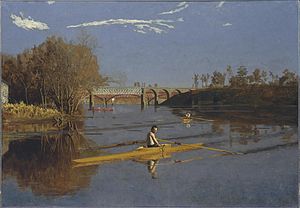
Rowing, sometimes called crew in the United States, is the sport of racing boats using oars. It differs from paddling sports in that rowing oars are attached to the boat using oarlocks, while paddles are not connected to the boat. Rowing is divided into two disciplines: sculling and sweep rowing. In sculling, each rower holds two oars—one in each hand, while in sweep rowing each rower holds one oar with both hands. There are several boat classes in which athletes may compete, ranging from single sculls, occupied by one person, to shells with eight rowers and a coxswain, called eights. There are a wide variety of course types and formats of racing, but most elite and championship level racing is conducted on calm water courses 2 kilometres (1.2 mi) long with several lanes marked using buoys.

The Biglin Brothers: John, James (1851–1917) and Bernard (Barney) (1840–1924) were brothers from New York active in professional rowing during the decade following the American Civil War, when rowing was one of America’s most popular spectator sports. John and Barney were the subject of a series of eleven paintings by Thomas Eakins.

The Stotesbury Cup Regatta, sponsored by the Schuylkill Navy, is the world's oldest and largest high school rowing competition. It is held annually in mid-May over a two-day period on the Schuylkill River near Boathouse Row in Philadelphia, Pennsylvania. Competing crews come from schools all over North America, though most hail from the Northeastern and Mid-Atlantic United States.
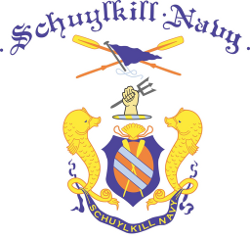
The Schuylkill Navy is an association of amateur rowing clubs of Philadelphia. Founded in 1858, it is the oldest amateur athletic governing body in the United States. The member clubs are all on the Schuylkill River where it flows through Fairmount Park in Philadelphia, mostly on the historic Boathouse Row.
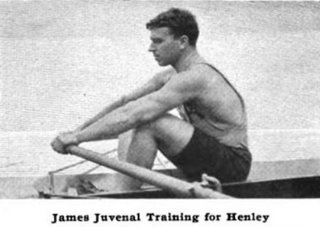
James Benner Juvenal was an American rower, born in Philadelphia, who competed in the 1900 Summer Olympics and in the 1904 Summer Olympics.
Robert Buchanan Gerhardt was an American insurance businessman and broker. As a young rower, he won a bronze medal in coxed four crew in the 1924 Summer Olympics in Paris.
Henry Reed Welsford was an American Sanitary Engineer who as a young rower competed in the 1924 Summer Olympics in Paris. In 1924 he won the bronze medal as a member of the American boat in the coxed four event.

Bachelors Barge Club is an amateur rowing club located at #6 Boathouse Row in the historic Boathouse Row of Philadelphia, Pennsylvania. It is the oldest continuously operating boathouse in the United States. It went through renovations as part of the "Light Boathouse Row" initiative, in which new LED lights were fitted to each of the boathouses. Bachelors Barge Club is currently home to several programs, including the Conestoga High School Crew Team, and the Drexel University Crew Team, among several others.

Wrestlers is a name shared by three closely related 1899 paintings by American artist Thomas Eakins,. The Los Angeles County Museum of Art (LACMA) owns the finished painting (G-317), and the oil sketch (G-318). The Philadelphia Museum of Art (PMA) owns a slightly smaller unfinished version (G-319). All three works depict a pair of nearly naked men engaged in a wrestling match. The setting for the finished painting is the Quaker City Barge Club (defunct), which once stood on Philadelphia's Boathouse Row.

Fairmount Rowing Association is an amateur rowing club, founded in 1877. The facility, located at #2 Boathouse Row in the historic Boathouse Row of Philadelphia, Pennsylvania, is on the National Register of Historic Places. Fairmount originally catered to blue-collar youths living in the Fairmount neighborhood. In 1916, after decades of being rejected, the club was finally allowed to join the Schuylkill Navy. The Club boasts being known as the "premiere club for Masters rowing in the mid-Atlantic region" and has produced several world class rowers.
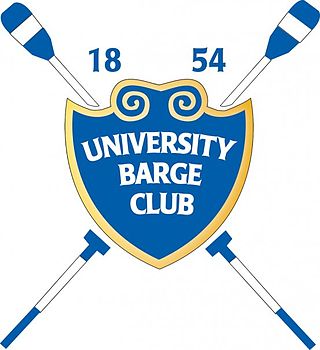
University Barge Club of Philadelphia is an amateur rowing club located at #7 in the historic Boathouse Row of Philadelphia, Pennsylvania. It is listed on the National Register of Historic Places and designated a National Historic Landmark. The club's founding, in 1854, is considered the "dawn of organized athletics in the University of Pennsylvania." Known as "the upper-class rowing club," UBC is a founder, and the most senior member, of the oldest amateur athletic governing body in the United States, the Schuylkill Navy.

Pennsylvania Barge Club is an amateur rowing club, situated along the historic Boathouse Row of Philadelphia, Pennsylvania. It was founded in 1861 and joined the Schuylkill Navy in 1865. The club's boathouse, at #4 Boathouse Row, is also known as the Hollenback House, named for William M. Hollenback, Jr., who served as President of USRowing from 1979 until 1985.

Crescent Boat Club is an American amateur rowing club located at #5 Boathouse Row in the historic Boathouse Row of Philadelphia, Pennsylvania. It was founded in 1867 when Pickwick Barge Club and Iona Barge Club merged. Crescent Boat Club joined the Schuylkill Navy in 1868. In 1871, Crescent competed in and won the doubles event in the first regatta of the National Association of Amateur Oarsmen, an event "which undoubtedly helped the sport greatly."

Penn Athletic Club Rowing Association is an amateur rowing club located at #12 Boathouse Row in the historic Boathouse Row of Philadelphia, Pennsylvania. Penn AC was founded in 1871 as the West Philadelphia Boat Club. Penn AC has been a destination for elite rowers looking to make the US National Team, ever since John B. Kelly Sr. joined Penn AC after a schism with his former club, Vesper.
The Vesper Boat Club is an amateur rowing club located at #10 Boathouse Row in the historic Boathouse Row of Philadelphia, Pennsylvania. Founded in 1865 as the Washington Barge Club, the club's name was changed to Vesper Boat Club in 1870.

Undine Barge Club is an amateur rowing club located at #13 Boathouse Row in the historic Boathouse Row along the Schuylkill River in Philadelphia, Pennsylvania. The club was founded in 1856. Undine was not initially listed as a founder of the Schuylkill Navy, but is now considered a founder because an Undine member, Mr. B. F. Van dyke, was elected to represent the club as secretary treasurer of the Navy from its birth in 1858. In 1860, Undine purchased Keystone Barge Club's boat and equipment, as Keystone had disposed of its boathouse.

The Girard Avenue Bridge is an automobile and trolley bridge in Philadelphia, Pennsylvania, that carries Girard Avenue over the Schuylkill River. It connects the east and west sections of Fairmount Park, and the Brewerytown neighborhood with the Philadelphia Zoo. The current bridge is the third built on the site.

Pennsylvania Railroad, Connecting Railway Bridge is a stone arch bridge in Philadelphia, Pennsylvania, that carries Amtrak Northeast Corridor rail lines and SEPTA and NJT commuter rail lines over the Schuylkill River. It is located in Fairmount Park, just upstream from the Girard Avenue Bridge.

The Thomas Eakins Head of the Schuylkill Regatta is a rowing race held annually during the last weekend in October on the Schuylkill River in Philadelphia, Pennsylvania. The HOSR is the final race in the Fall Fury series, which includes the Head of the Ohio and the Head of the Connecticut. Along with the Head of the Charles and the Head of the Connecticut, the HOSR is considered one of the three “fall classics.” The HOSR is one of the marquee races in the Philadelphia Classic Regatta Series, which also includes the Stotesbury Cup Regatta, the Philadelphia Scholastic Rowing Championship, the Schuylkill Navy Regatta, and the Independence Day Regatta.
Regattas such as the Head of the Charles in Boston and the Head of the Schuylkill in Philadelphia are to the rowing world what the New York Marathon and the Boston Marathon are to running.
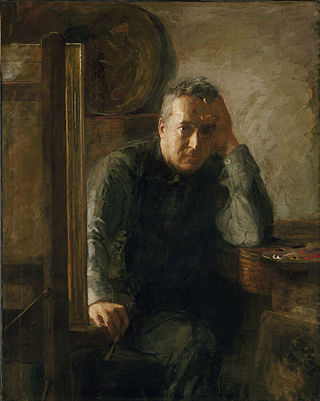
Charles Bregler was an American portrait painter and sculptor, and a student of artist Thomas Eakins. Bregler wrote about Eakins's teaching methods, and amassed a large collection of his minor works, memorabilia and papers. Following Bregler's death, his widow safeguarded the Eakins collection for decades before selling it to the Pennsylvania Academy of the Fine Arts.
